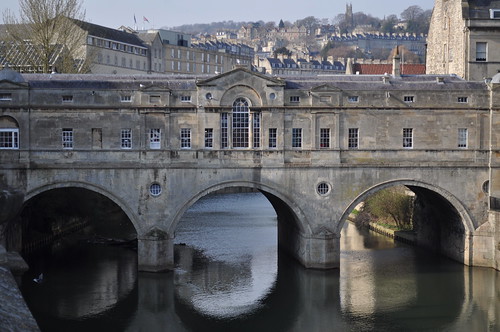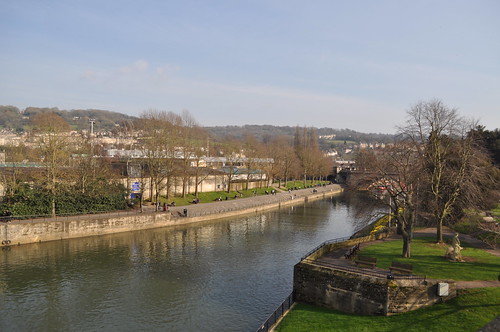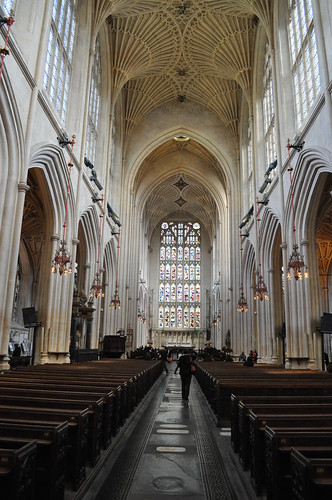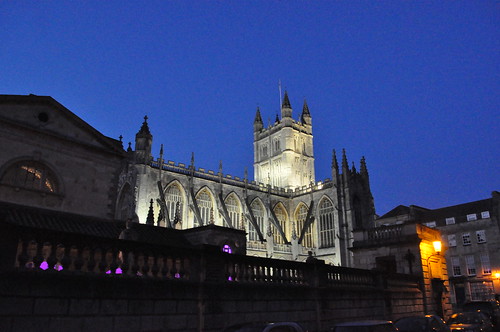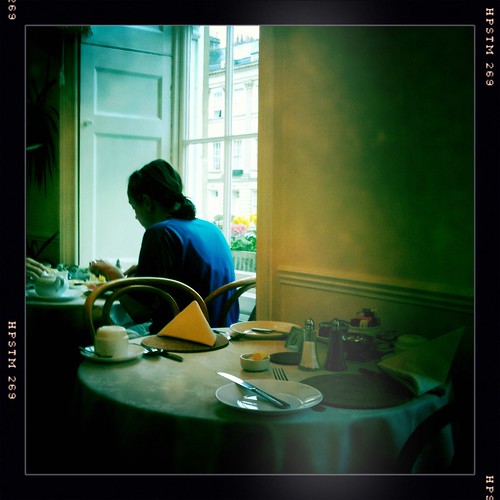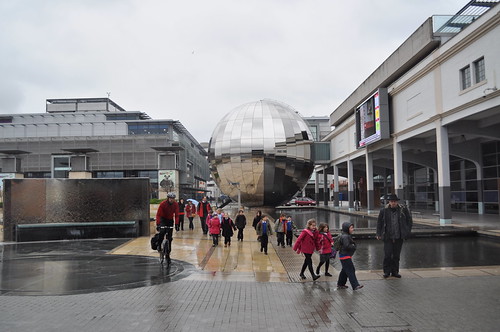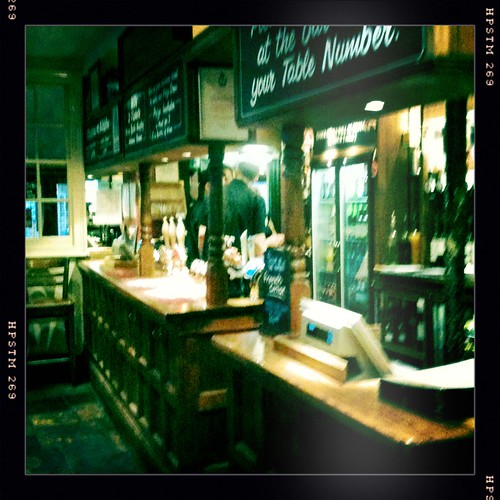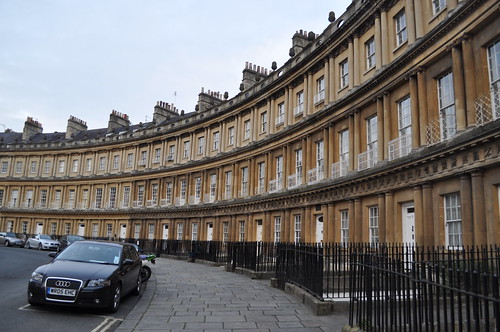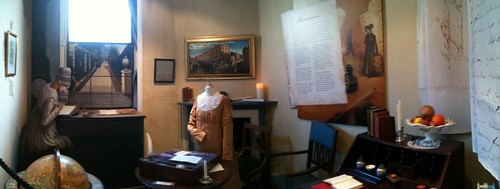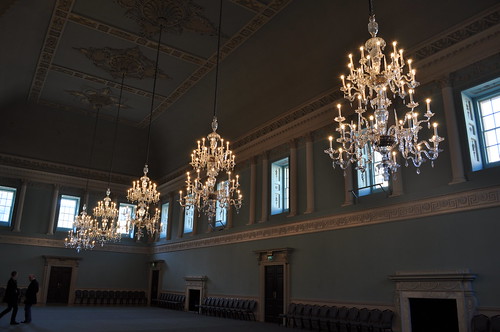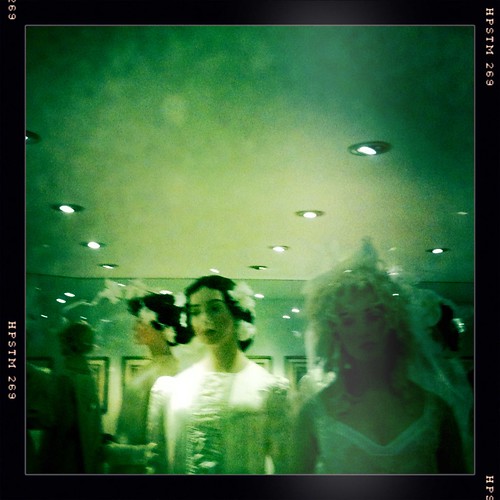We're now back in Cambridge, after a long and pleasant couple days in the West of England. I really enjoyed it, both as a tourist, and in my capacity as Mr. Contemplative Computing.
We got to Bath on Thursday afternoon, and decided to walk to the hotel. This turned out to be a good move, because Bath is A Small Place. The train station is beautifully well-situated, not in the middle of things but on a street that takes you straight to Bath Abbey and the center of town; a block further is the Pulteney Bridge, and our hotel was just a couple blocks from there.
So if you want to go to the University or see some of the more out-of-the-way gardens you need a cab or bus, but much of what you want to see if within a few square blocks: the Roman baths, the Abbey, the Crescent, Circle, even the Saracens' Head (a pub where Charles Dickens lived, and which shows off Britain's proud history of multiculturalism).
After checking into the guest house, we went to the Abbey, and walked around the city. I couldn't help but notice that Bath Abbey is a fantastic, majestic space (though with terrible acoustics, apparently), and it literally overshadows the Latter-Day Saints church and Quaker meeting house nearby.
We then had dinner at a little Italian pizza place. After that it was a drink at the Coeur de Lion, which advertised itself as the smallest pub in Bath.
We stayed at a little place called the Edgar Townhouse, on Great Pulteney Street. We got put in a basement room, which turned out to be fine, though it was cozy. But the breakfast was good.
Friday we went to Bristol for my talk. Bristol is only about 15 minutes away on the train, and the Watershed and other restored stuff is maybe 20 minutes from Temple Meads.
The docks and shipyard, which had connected this part of Britain with the rest of the world, closed in the 1960s and 1970s, and so for a long time large parts of the city were derelict; they've now been revived, with the mix of science, media, Cal-Mex and Japanese cuisine, tax forgiveness, and startup space that are essential for such New City enterprises.
We saw a little of it, but after my talk headed back to Bath in time to go to the Roman Baths, which I found REALLY cool. For one thing, it's like two exhibit spaces in one: there are the original Roman baths, which have been the subject of some elaborate archaeological excavations, and the Victorian improvements, which involved things like carving new statues of Julius Caesar.
Like the medieval Stockholm museum, or the Turku museum, this one takes you through the archaeological site, rather than just presenting you with exhibits from the dig; it's a style of presentation that I really like.
What was odder was seeing large numbers of fellow visitors listening to audio tours. It was a bit zombie-like, though I'm sure there are things they learned that I didn't. I'll have to go back to my Pevsner series volume on Bath to get caught up.
After that we had dinner at the Crystal Palace, a pub and restaurant just down the street from the baths.
I'm glad we got to see Bath on Thursday and Friday, because Saturday it was packed. Like Cambridge, the crowds are mad, with tons of people in the pedestrian-only shopping mall, cueing up for the Roman Baths and Pump Room, and generally being everywhere. Nonetheless, we made the best of it.
We spent part of the morning at the Jane Austen Centre, a house converted into a museum for Jane Austen fans. Though these days, it's really devoted to that version of Jane Austen that's filtered through the movies; so much so that Austen herself (as well as all her other characters) are in danger of being upstaged by Mr. Darcy– in particular the Colin Firth version of Mr. Darcy. Actually, most of the museum is about Austen and Bath in her time; it's more the gift shop that has turned into the House of Firth. (The "I [Heart] Mr Darcy" bumper stickers and tote bags nearly sent my wife over the edge.)
Bath's relationship to Jane Austen is emblematic of the mix of honest and commercialism that at their best English historical sites manage to strike. The message can be reduced to, "Jane Austen reluctantly came to his city with her elderly parents, and over the next five years, endured the loss of her beloved father, the decline of her family's status, constant marginalization in a city obsessed with wealth and fashion, and a creative drought that represents an incalculable loss given her short life. Don't forget to visit the gift shop!"
After that, we went to the Assembly Rooms and the Fashion Museum. The Assembly Rooms are a great space, featured in several scenes in Persuasion (there really is NO escaping Jane Austen here– I recognized several places from the movies, and the fact that the Rooms are on Bennett Street cannot but raise an eyebrow).
The Fashion Museum is fascinating, though perhaps for me not quite in the ways the creators meant. It's one of those museums where the curatorial and research work are not hidden away but are worked into the exhibits, which is something I always appreciate. (It's used to incredible and often devastating effect in the Jewish Museum in Vienna.) And while I'm not hugely knowledgeable about fashion, though I'm not as dismissive about it as I used to be, I did find it educational.
I'm pretty sure the designers did not intend to invoke postmodern / dystopian anime, but in the exhibit on wedding gowns (thank you so much, Kate Middleton), I was seized by the memory of the cyborg factory shootout scene in Ghost in the Shell 2, and for the life of me could not get it out of my mind.
Being around historical exhibits doesn't usually make me want to be armed, but this did.
So it was an excellent time, but it's also nice to be back in Cambridge.
